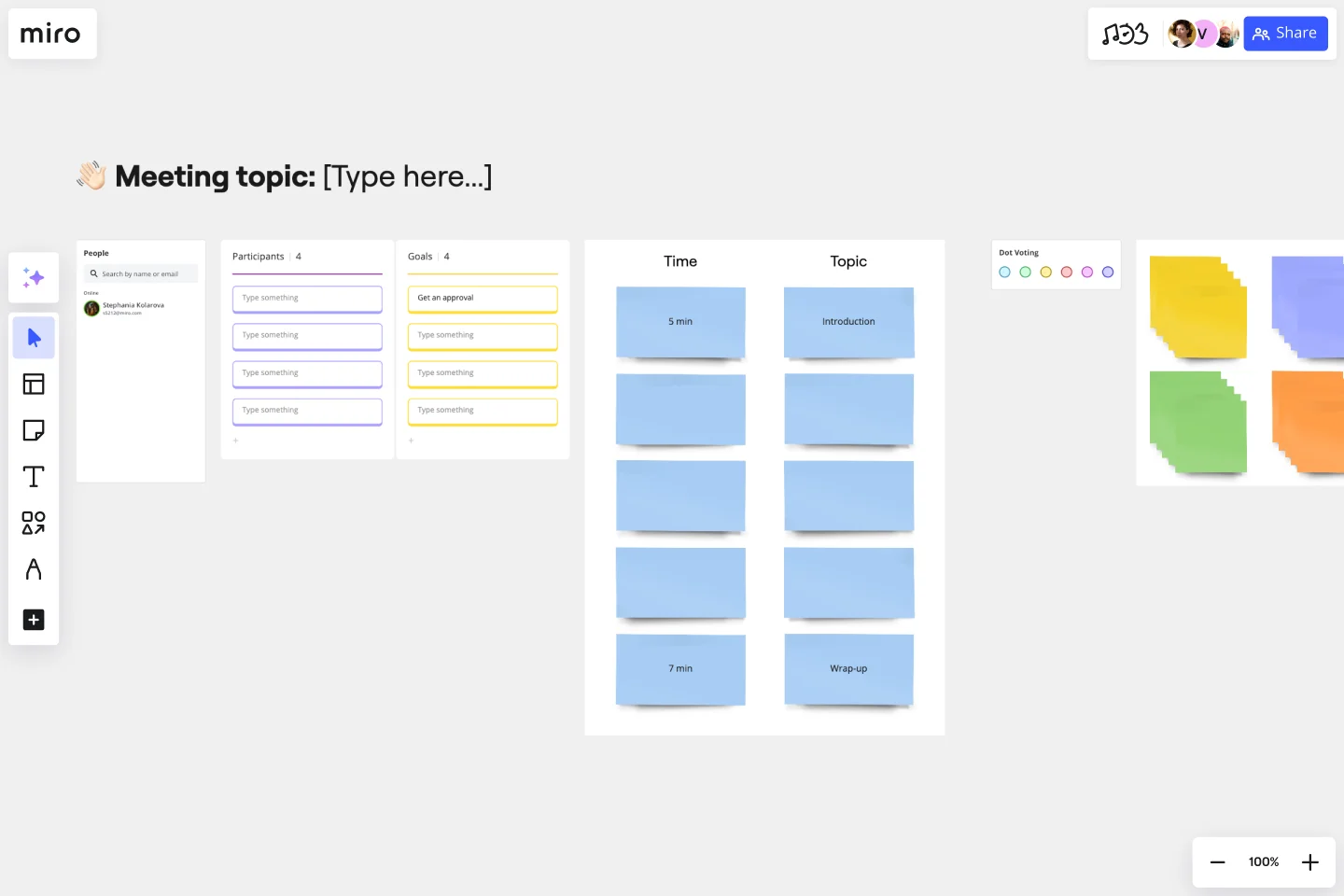Meeting Template
Run better, more collaborative team meetings that set your team up for success.
About the Meeting Template
Everyone has been in a meeting that didn’t go as planned. Maybe it ran off course, or you ran out of time to accomplish everything you set out to do — or maybe it just felt like a waste of time.
To avoid that, it’s important to prepare to run a team meeting ahead of time. With this simple but effective meeting template, you can prepare to run a team meeting that ticks all the boxes. Set your teammates up for success, give everyone the time and space to contribute, and keep your projects on track.
How to use the meeting template
Miro's meeting template can be used any time you’re running a remote, hybrid, or in-person meeting. Start by adding the meeting template to your Miro board, then take the following steps to make it your own:
1. Determine the purpose of the meeting
One of the most common complaints about team meetings is that they feel like a waste of time. When people come to a meeting with the expectation that they won’t get anything out of it, they’re less likely to listen and contribute — and they might even start skipping meetings.
Before you start a meeting, ask your teammates what they would most like to see, do, or discuss. Is there something on which they would like the team’s input? Is there a challenge they’d like to talk about.
2. Build the meeting agenda
Prior to the meeting, take the time to create an agenda so everyone knows what the meeting is about before they step foot in the room (or virtual room). Be transparent about why you did and did not include certain items on the agenda.
3. Share the agenda items
Before the meeting, make sure everyone gets a copy of the agenda so they can prepare. Many people find it useful to list agenda items as questions. For example, instead of “editorial calendar,” you can try “should we update the editorial calendar?” A phrase like “editorial calendar” might leave participants wondering what exactly they’re going to talk about, which makes it more challenging for them to prepare. But using concrete language gives them something to prepare for. During the meeting, display the agenda on the board so everyone can refer to it as they discuss.
4. Allocate time for each topic
This ensures you will address every topic on the agenda without running out of time, and it allows your teammates to construct their questions and comments to fit the time they have been given. You can even start a timer when everyone begins discussing a given agenda time and agree to move onto the next item after a certain amount of time has elapsed.
5. Send meeting notes
After the meeting, make sure you send out a recap of what you discussed, in addition to the board itself. That way, everyone can refer back to their notes and hit the ground running.
Get started with this template right now.
SIPOC Template
Works best for:
Agile Methodology, Strategic Planning, Mapping
A SIPOC diagram maps a process at a high level by identifying the potential gaps between suppliers and input specifications and between customers and output specifications. SIPOC identifies feedback and feed-forward loops between customers, suppliers, and the processes and jump-starts the team to think in terms of cause and effect.
Ansoff Matrix Template
Works best for:
Leadership, Operations, Strategic Planning
Keep growing. Keep scaling. Keep finding those new opportunities in new markets—and creative new ways to reach customers there. Sound like your approach? Then this template might be a great fit. An Ansoff Matrix (aka, a product or market expansion grid) is broken into four potential growth strategies: Market Penetration, Market Development, Product Development, and Diversification. When you go through each section with your team, you’ll get a clear view of your options going forward and the potential risks and rewards of each.
3x3 Prioritization Method Template
Works best for:
Operations, Prioritization, Strategic Planning
It’s all about assessing a task or idea, and quickly deciding the effort it will take and the potential impact it will have—ranked low, medium, or high. That’s what the 3x3 prioritization method does: Help teams prioritize and identify quick wins, big projects, filler tasks, or time-wasters. With nine bucket areas, it offers slightly greater detail than the 2x2 Prioritization Matrix (or Lean Prioritization Method). It’s easy to make your own 3x3 prioritization matrix—then use it to determine what activities or ideas to focus on with your valuable resources.
Perceptual Map Template
Works best for:
Marketing, Desk Research, Mapping
To shape your messaging, tailor your marketing, improve your product, and build your brand, you have to know your customers’ perceptions — what they think of you and your competitors. You can gain those insights by exploring a perceptual map. This simple, powerful tool creates a visual representation of how customers rank your price, performance, safety, and reliability. Put this template to work and you’ll be able to size up your competition, see gaps in the market, and understand changes in customer behavior and purchasing decisions.
Year Timeline Template
Works best for:
Timeline, Planning
The Year Timeline template provides a comprehensive view of annual events and milestones. Perfect for planning yearly goals, tracking progress, and scheduling important dates, this template helps you stay organized and focused throughout the year.
Breakout Group Template
Works best for:
Education, Team Meetings, Workshops
Breakout groups provide an excellent opportunity for teammates to have candid conversations and connect on a more intimate level than is possible during a broader meeting. When you’re in a large group setting, it can be difficult for people to feel safe or comfortable speaking up. In a smaller group, participants can feel safer sharing their ideas. Since the group is more intimate, teams are empowered to participate rather than observe.
